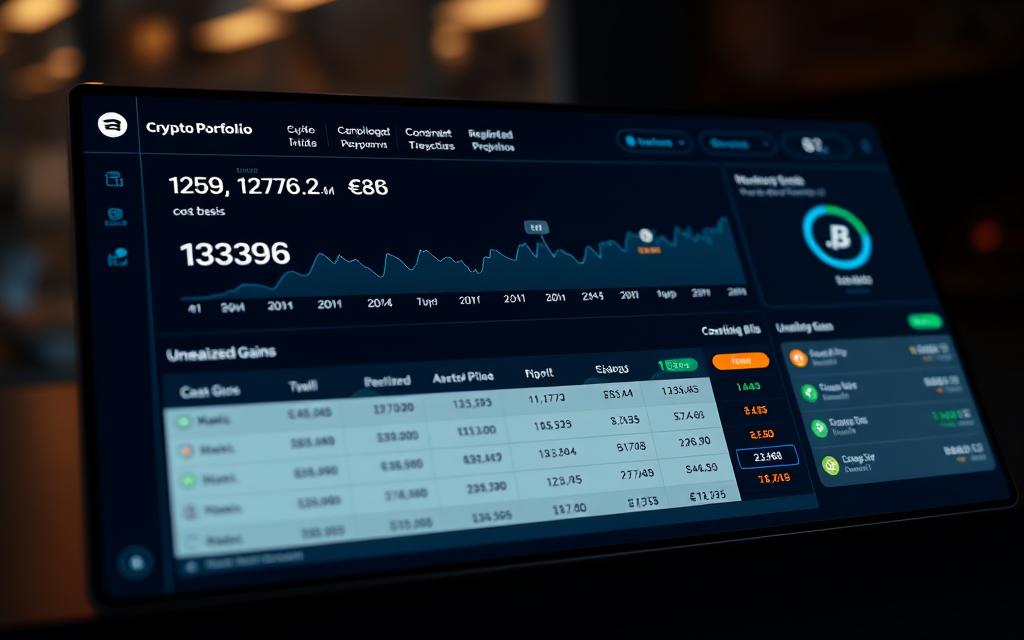Table of Contents
The IRS treats digital assets like property, meaning every trade or sale can trigger a tax event. Whether you’re buying, selling, or exchanging, each transaction may result in capital gains or losses.
Accurate record-keeping is crucial. The IRS requires reporting all crypto activities on your tax return. Failing to do so could lead to penalties. Tools like TurboTax now support crypto tracking, making compliance easier.
New for 2024, Form 1099-DA helps streamline reporting. Rates vary based on income and holding periods. Short-term gains face higher taxes than long-term investments.
Stay informed to avoid surprises. Proper documentation ensures smooth filing and minimizes audit risks.
Introduction to Cryptocurrency Taxation
Blockchain technology powers digital assets, creating secure transaction records. Unlike traditional money, these virtual currencies operate on decentralized networks. Every transaction is encrypted and verified by multiple participants, ensuring transparency.
The IRS clarified crypto’s status in Notice 2014-21, classifying it as property for tax purposes. This means buying, selling, or trading triggers taxable events. Tools like TurboTax simplify tracking up to 20,000 transactions.
Global adoption has surged, with over 2.5M digital assets in circulation. Below is a snapshot of the market’s growth:
| Year | Total Cryptocurrencies | Market Value (USD) |
|---|---|---|
| 2020 | 1.2M | $0.8T |
| 2024 | 2.5M | $2.41T |
Since 2020, Form 1040 includes a crypto question. Proper reporting avoids penalties and aligns with IRS guidelines. Understanding these basics ensures compliance as the market evolves.
How Are Cryptocurrency Profits Taxed?
Tax rules for digital assets depend on holding periods and income levels. The IRS divides capital gains into two categories: short-term (held ≤1 year) and long-term (held >1 year). Rates range from 0% to 37%, with higher brackets for quick trades.
Short-term capital gains align with ordinary income tax rates. For 2024, these vary by filing status:
| Filing Status | 10% Rate | 12%–37% Rates |
|---|---|---|
| Single | Up to $11,600 | $11,601–$609,350+ |
| Married (Joint) | Up to $23,200 | $23,201–$731,200+ |
Long-term capital gains enjoy lower rates—0%, 15%, or 20%—based on income. For example, singles earning under $47,025 pay 0% on assets held over a year.
Mining and staking rewards count as ordinary income. Losses offset gains, but deductions cap at $3,000 annually. Unlike stocks, crypto isn’t subject to wash sale rules.
High earners face an extra 3.8% net investment income tax. Proper planning reduces liabilities, especially for frequent traders.
Cryptocurrency as Property: IRS Classification
The IRS categorizes digital assets as property, similar to stocks or real estate. This means every transaction—selling, trading, or spending—can trigger taxable events. The legal basis stems from Notice 2014-21, which clarified crypto’s status for tax purposes.
Like traditional investments, holdings may generate capital gain or loss. Key differences exist:
- Gifting: Transfers under $18,000 (2024) are tax-free, but recipients inherit the original cost basis.
- Inheritance: Assets receive a step-up in basis, reducing future tax liabilities.
- Foreign currency: Crypto isn’t treated as currency under IRS rules, unlike euros or yen.
State laws vary. Texas and Wyoming exempt crypto from property taxes, while California taxes it like securities. The IRS prioritizes audits for:
- Unreported transactions exceeding $10,000
- Discrepancies between Form 1099-DA and filed returns
- High-volume traders with inconsistent cost-basis records
Proper IRS classification ensures compliance. Missteps could lead to penalties or audits.
Taxable Events in Cryptocurrency
Every crypto transaction carries potential tax consequences. The IRS treats activities like trading, spending, or receiving digital assets as taxable events. Proper tracking ensures compliance and avoids penalties.
Buying and Selling Crypto
Selling digital assets for fiat currency triggers a capital gain loss calculation. The IRS compares the sale price to the original cost basis. For example, if you bought Litecoin at $300 and sold for $500, the $200 profit is taxable.
Key triggers include:
- Sales: Converting crypto to cash.
- Trades: Swapping tokens (e.g., Bitcoin to Ethereum).
- Debit card spending: Each purchase counts as a sale.
Exchanging Cryptocurrencies
Trading one token for another is taxable. The IRS uses the fair market value at the time of exchange. Tools like TurboTax Premium automate cost-basis adjustments for fees.
| Action | Tax Implication |
|---|---|
| Crypto-to-crypto swap | Capital gains on the disposed asset |
| Airdrops | Ordinary income at receipt |
Using Crypto for Goods and Services
Paying for goods services with crypto is a sale. If you spent $500 Litecoin (originally bought for $200) on plane tickets, the $300 gain is taxable. Merchant acceptance grew 78% since 2022, increasing these transactions.
For deeper insights, explore taxable events in crypto.
Capital Gains Tax Rates for Crypto
Understanding crypto tax rates helps investors plan transactions strategically. The IRS applies different rates based on holding periods and income brackets. Proper planning minimizes liabilities and maximizes returns.
Short-Term vs. Long-Term Capital Gains
Assets held ≤1 year face short-term capital gains taxes, matching ordinary income rates. For 2024, these range from 10% to 37%. Frequent traders often fall into higher brackets.
Long-term capital gains apply to holdings >1 year. Rates drop to 0%, 15%, or 20%, depending on income. Single filers earning under $47,025 pay 0%—a key incentive for patient investors.
2024 Tax Rate Tables
Below is a breakdown of federal rates for crypto gains:
| Filing Status | 0% Rate (Long-Term) | 15%–20% Rates (Long-Term) |
|---|---|---|
| Single | ≤$47,025 | $47,026–$518,900+ |
| Married (Joint) | ≤$94,050 | $94,051–$583,750+ |
State taxes vary. California adds up to 13.3%, while Texas imposes no additional levy. Married couples filing separately face higher thresholds than joint filers.
Optimization strategies include:
- Holding assets >1 year to qualify for lower rates.
- Using tax-loss harvesting to offset gains with losses.
- Reviewing state laws to avoid surprises.
Calculating Crypto Gains and Losses
Calculating gains and losses requires understanding cost basis methods. This figure represents the original value of an asset, including purchase price and additional costs like transaction fees. Accurate records prevent overpaying taxes or triggering audits.

Determining Cost Basis
The IRS allows two primary methods to calculate cost basis:
- FIFO (First-In, First-Out): Default method; sells oldest assets first.
- Specific Identification: Lets you choose which assets to sell, optimizing tax outcomes.
For example, selling $1,000 Bitcoin with a $200 fee reduces taxable gains to $800. Adjusted cost basis includes fees, mining equipment depreciation, and hard fork allocations.
Adjusting for Fees and Transactions
Transaction fees directly impact gains. Wallet-to-wallet transfers aren’t taxable, but documentation is critical. TurboTax’s crypto calculator automates adjustments for:
- Exchange fees
- Network charges
- Staking rewards
In 2025, new rules will standardize basis tracking across platforms. Proactive planning ensures compliance and minimizes liabilities.
Reporting Cryptocurrency on Tax Returns
New tax forms simplify crypto reporting but demand attention to detail. The IRS requires investors to report transactions using Form 8949 and Schedule D. Starting in 2025, Form 1099-DA will become mandatory for exchanges, streamlining compliance.
Form 8949 and Schedule D
Form 8949 lists every sale or trade of digital assets. Each line includes:
- Date acquired and sold
- Cost basis and proceeds
- Gain or loss calculations
Totals transfer to Schedule D. Discrepancies trigger audits. TurboTax auto-imports data from major exchanges, reducing errors.
Form 1099-DA (2025 Updates)
The new Form 1099-DA standardizes reporting for brokers. Key boxes cover:
- Gross proceeds from sales
- Adjusted cost basis
- Withholding details
Non-compliance penalties start at $250 per violation. Proactive reconciliation avoids fines.
Mining Cryptocurrency: Tax Implications
Mining digital assets creates unique tax obligations under IRS guidelines. Rewards from mining are treated as ordinary income at their fair market value upon receipt. This applies whether you mine solo or through a pool.
The IRS distinguishes between hobby mining and business operations. Casual miners report earnings as “other income,” while professional miners file Schedule C. Deductions like electricity and hardware costs reduce taxable income for full-time miners.
Self-employed miners face self-employment tax (15.3%) on net earnings. Quarterly estimated payments may be required to avoid penalties. Proper documentation of expenses—such as ASIC depreciation over 5 years—is critical for audits.
Pool mining requires precise allocation tracking. Each participant’s share of rewards must be reported as income tax liability. Tools like Koinly automate this for miners with complex portfolios.
Brokers issue Form 1099-NEC if mining payments exceed $600 annually. State rules vary: Texas exempts mining from sales tax, while Alaska taxes it as intangible property. Always consult a tax professional for multi-state operations.
Staking Rewards and Taxation
Staking rewards generate taxable income under IRS rules. Unlike mining, staking relies on Proof-of-Stake (PoS) networks, where validators earn rewards for securing the blockchain. The IRS treats these earnings as *ordinary income* at fair market value when received.
- PoS rewards come from holding tokens, while PoW requires computational power.
- Delegated staking (e.g., via exchanges) still triggers tax liability for the delegator.
- Liquid staking (tradable tokens) vs. illiquid (locked assets) affects reporting flexibility.
Reward timing matters. The IRS recognizes income when rewards are controllable, even if unsold. Cross-chain staking adds complexity—each network’s native token may have different tax rules.
TurboTax now supports staking income tracking, automating cost-basis calculations. Proper documentation prevents audits, especially for high-volume stakers.
Airdrops and Hard Forks: Taxable Income?
Free tokens from airdrops and blockchain splits often come with hidden tax obligations. The IRS clarified in a 2019 memo that these events generally count as taxable income when you gain control of the assets.

- Substantial services test: Promotional airdrops (e.g., for marketing tasks) are always taxable, while community rewards may avoid it.
- Hard forks require documenting chain splits. Wrapped tokens (like WBTC) follow the same rules as original assets.
Famous cases like Uniswap’s 2020 airdrop ($1,200+ per claim) show valuation challenges. The IRS expects recipients to report fair market value at receipt, even if unsold.
“Taxpayers must include airdrops in gross income when they have dominion and control.”
Losses from abandoned forks aren’t deductible. Proper records—including wallet addresses and dates—are critical for compliance.
Crypto Donations and Charitable Contributions
Donating digital assets offers unique tax benefits under IRS rules. Contributions to qualified nonprofits may qualify for a tax deduction based on the asset’s fair market value at the time of transfer. Gifts exceeding $250 require written acknowledgment from the charity.
Donor-advised funds (DAFs) streamline crypto philanthropy. These accounts let donors contribute tokens, claim an immediate tax deduction, and recommend grants later. Popular platforms like Fidelity Charitable support crypto DAFs.
Large donations often need professional appraisals. The IRS mandates valuations for gifts exceeding $5,000. Use IRS Form 8283 for non-cash charitable contributions over $500.
Carryover rules allow unused deductions for up to five years. Verify charity eligibility via the IRS Tax Exempt Organization Search. Environmental projects may offer additional state incentives.
TurboTax’s It’s Deductible tool simplifies tracking. It calculates values automatically, ensuring compliance with evolving regulations.
Lost or Stolen Crypto: Can You Deduct Losses?
Losing access to digital assets creates complex tax challenges under current IRS rules. The Tax Cuts and Jobs Act (TCJA) suspended casualty losses for personal property until 2025, including crypto. Exceptions exist for federally declared disasters or theft losses tied to criminal investigations.

- Proof of ownership (wallet addresses, transaction IDs)
- Evidence of criminal intent (hacking, fraud)
- Documented fair market value at the time of loss
Exchange bankruptcies (e.g., FTX) complicate claims. The IRS treats unrecoverable funds as capital losses, deductible up to $3,000 annually against gains. Insurance reimbursements reduce eligible loss amounts.
| Loss Type | Deductible? | Requirements |
|---|---|---|
| Private Key Mismanagement | No | IRS views as personal negligence |
| Ponzi Schemes | Yes | Form 4684 + SEC/FBI case number |
Forensic tools like Chainalysis help trace stolen funds. The IRS may require blockchain analysis reports for audits. Keep records for 7 years to support claims.
“Losses from theft must be sudden and identifiable. Gradual depreciation or market crashes don’t qualify.”
Tax-Free Crypto Transactions
Strategic planning unlocks tax-free opportunities in digital asset management. The IRS allows exemptions for specific actions, like holding long-term or using specialized accounts. Understanding these rules minimizes liabilities legally.
Holding vs. Selling
Simply holding digital assets incurs no taxes. Gains trigger only upon selling or trading. Long-term holdings (1+ years) qualify for lower capital gains rates—0% for incomes under $47,025 (2024).
Tax-Advantaged Accounts (IRAs)
IRAs let investors grow crypto tax-deferred or tax-free. Key options:
- Roth IRAs: Contributions use post-tax dollars; withdrawals are tax-free after age 59½.
- Prohibited transactions: Self-directed IRAs can’t purchase assets from disqualified persons.
- 401(k) funds: Some plans now offer crypto exposure through institutional custody.
For 2024, contribution limits are $6,500 ($7,500 if 50+). Inherited IRAs require distributions within 10 years, but beneficiaries avoid immediate taxes.
IRS Enforcement and Crypto Tracking
The IRS has intensified efforts to monitor digital asset transactions using advanced tracking tools. Partnerships with firms like Chainalysis enable forensic analysis of blockchain data. A 2024 John Doe summons to Coinbase expanded access to user records, signaling tighter scrutiny.
![]()
- Chainalysis contracts: Tools trace transactions across wallets, identifying patterns linked to *tax evasion*.
- Travel Rule compliance: Exchanges must share sender/receiver data for transfers over $3,000.
- Mixer/tumbler red flags: Privacy tools trigger audits due to obfuscation risks.
The IRS encourages voluntary disclosure via Form 14457. Whistleblowers earn 15%–30% of recovered funds under updated programs. International treaties, like the U.S.-Swiss agreement, streamline cross-border data sharing.
“Undisclosed crypto holdings face penalties up to 75% of owed taxes plus criminal charges.”
Proactive reporting minimizes risks. Tools like TurboTax integrate blockchain analytics to simplify compliance. Audits focus on discrepancies between Form 1099-DA and filed returns.
Keeping Records of Crypto Transactions
Accurate documentation of digital asset activities is critical for IRS compliance. Detailed transaction records protect against audits and streamline tax filings. Tools like CoinTracker automate tracking, but manual backups are essential.
Crypto tax software simplifies integration via APIs. Connect exchanges like Coinbase for real-time syncs. Always verify API permissions to limit data access. CSV files offer a fallback—ensure columns include dates, amounts, and wallet addresses.
Hardware wallets require extra attention. Export logs quarterly, noting transfers between cold storage and exchanges. DeFi platforms complicate tracking due to smart contract interactions. Label liquidity in/out transactions clearly.
NFTs demand metadata preservation. Record contract addresses and purchase prices. The IRS may request proof of ownership during audits. Store files securely for seven years, matching Form 8949 requirements.
“Disorganized records delay refunds and increase audit risks. Digital tools bridge the gap between blockchain complexity and IRS expectations.”
Proactive organization saves hours during tax season. Use folders for each year, separating trades, rewards, and donations. Cloud backups with encryption add security. Consistency is key—update logs weekly.
Common Cryptocurrency Tax Mistakes
Many investors unknowingly trigger IRS audits by mishandling digital asset taxes. A 2024 study found 75% of users underreport transactions, risking penalties. Small oversights—like forgotten trades or misclassified income—compound into costly errors.
- Ignoring gas fees: Network charges adjust cost basis but are often omitted.
- Misclassified mining income: Rewards count as ordinary income, not capital gains.
- State nexus issues: Multi-jurisdiction filers overlook local tax laws.
The IRS targets discrepancies in Form 1099-DA filings. For example, missing hard forks or airdrops creates underreported income gaps. Automated tools like Koinly flag these omissions before submission.
“Even $10 unreported transactions can snowball into audit triggers. Precision matters.”
Form errors escalate penalties. Using FIFO instead of specific identification may overstate gains. Proactive reviews with tax professionals prevent these pitfalls.
Conclusion
Navigating the complexities of digital asset taxes requires proactive planning and reliable tools. Mark key deadlines like April 15th for filings and January 31st for exchange forms. The 2025 Form 1099-DA rollout will standardize reporting—prepare by organizing records now.
Software like TurboTax simplifies tracking, while audit risks drop with consistent documentation. Multi-state filers should review local laws; nine states levy no income taxes. For advanced strategies, explore capital gains tax strategies.
Stay updated through IRS bulletins and consult a tax professional for personalized guidance. Continuous learning ensures compliance as regulations evolve.
FAQ
What is the IRS classification for digital assets?
The IRS treats cryptocurrencies as property, not currency. This means capital gains tax rules apply when selling, trading, or using them for goods and services.
How do I report transactions on my tax return?
You must report all taxable events on Form 8949 and summarize them on Schedule D. Starting in 2025, brokers will issue Form 1099-DA for reporting.
What’s the difference between short-term and long-term capital gains?
Short-term applies to assets held under one year and is taxed as ordinary income. Long-term gains apply after one year, with lower rates (0%, 15%, or 20%).
Are staking rewards considered taxable income?
Yes. The fair market value of rewards when received counts as ordinary income. Selling them later may trigger additional capital gains tax.
Can I deduct losses from stolen or lost crypto?
Only if the loss is due to theft or casualty. You’ll need proof (e.g., police reports) and must itemize deductions on your tax return.
Do I owe taxes if I exchange one virtual currency for another?
Yes. Trading crypto-to-crypto is a taxable event. You must calculate the gain or loss based on the fair market value at the time of the transaction.
How do I calculate cost basis for digital assets?
Your basis includes the purchase price plus fees. Methods like FIFO (First-In-First-Out) or specific identification determine which assets were sold.
Are airdrops and hard forks taxable?
Airdrops are taxable as ordinary income when received. Hard forks may be taxable if you gain control of new coins.
Can I avoid taxes by holding crypto in an IRA?
Yes. Crypto held in a self-directed IRA grows tax-deferred (Traditional IRA) or tax-free (Roth IRA). Withdrawals may still trigger taxes.
What records should I keep for tax purposes?
Save dates, amounts, wallet addresses, and transaction IDs. Track fair market value in USD at the time of each transaction.









